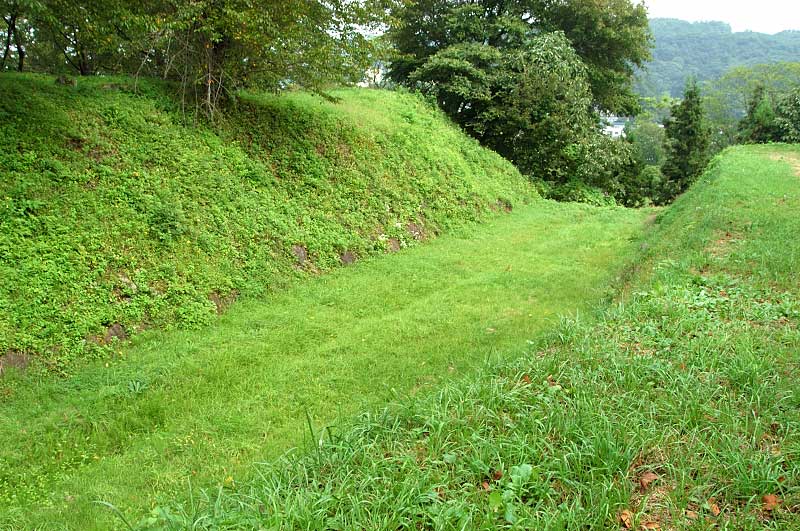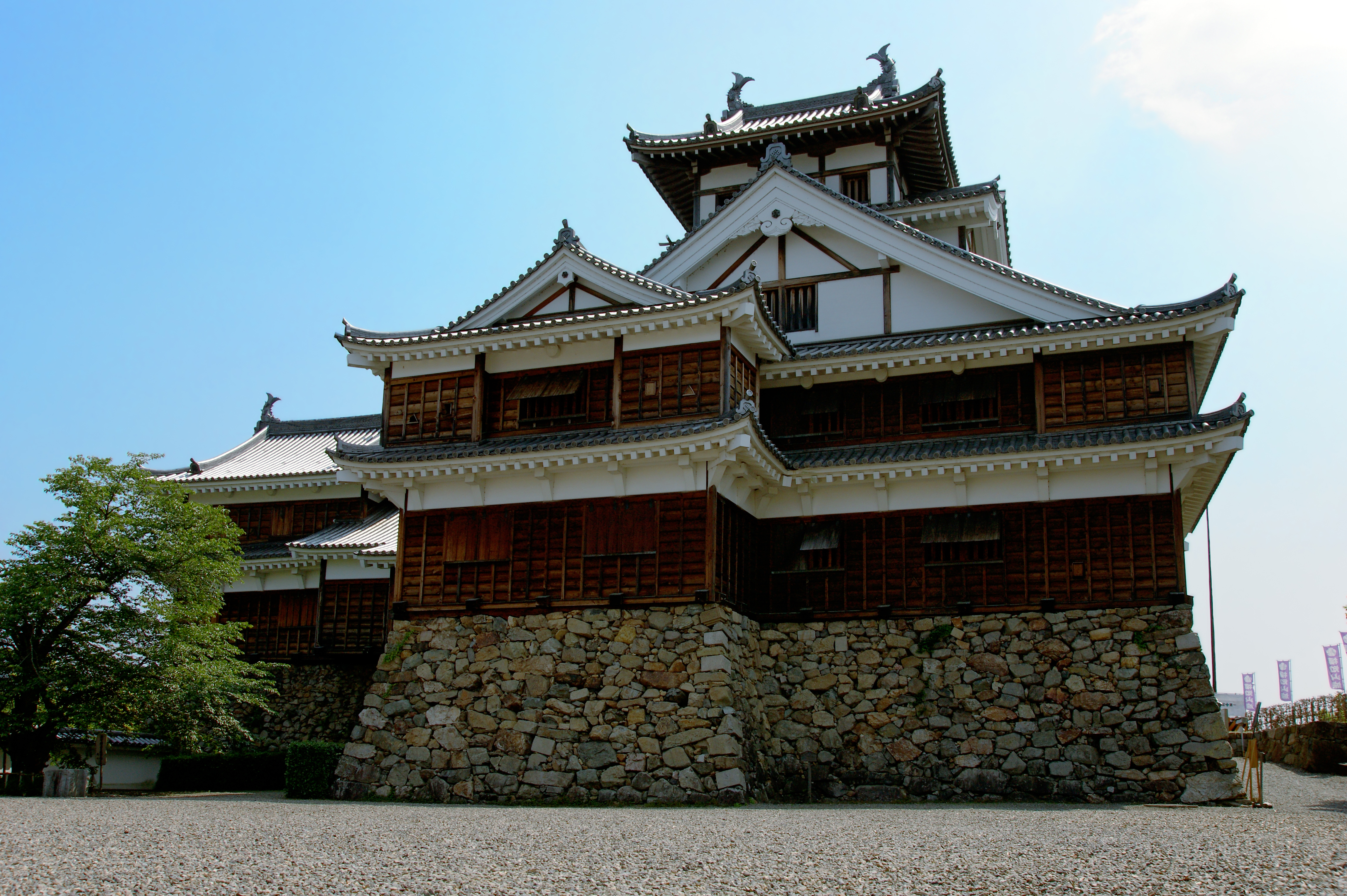|
Kunohe Castle
was a Japanese castle controlled by the Nanbu clan located in what is now the city of Ninohe, Iwate Prefecture, in the Tōhoku region of far northern Japan. It was also referred to as or . Description Kunohe Castle was a ''hirayama''-style castle built on a river terrace overlooking a junction between the Mabechi River, Shiratori River and a small branch of the Shiratori River, which formed part of its natural defences to the north, west and east. The site covers an area of 340,000 square meters, making it one of the largest castle ruins in the Tōhoku region. As with similar contemporary castles (such as Ne Castle), the fortifications at Kunohe consisted of a number of dry moats, creating a number of enclosures, each with its own earthen ramparts: the main bailey, second bailey, and there smaller baileys (Matsunomaru, Ishizawadate, and Wakasadate). The entrance to the south was protected by a wide dry moat, and the area of the enclosures was over 500 square meters. History T ... [...More Info...] [...Related Items...] OR: [Wikipedia] [Google] [Baidu] |
Ninohe, Iwate
is a city located in Iwate Prefecture, Japan. , the city had an estimated population of 26,344, and a population density of 63 persons per km2 in 11,803 households. The total area of the city is . Geography Ninohe is located in far north-center Iwate Prefecture, bordered by Aomori Prefecture to the north. The northern end of the Kitakami Mountains, the 852.2 meter Mount Oritsume is in Ninohe. Approximately 70% of the city area is mountainous and forested. The upper reaches of the Mabechi River flows through the city. A portion of the city is within the borders of the Oritsume Basenkyō Prefectural Natural Park. Neighboring municipalities Aomori Prefecture * Nanbu *Sannohe *Takko Iwate Prefecture * Hachimantai * Kunohe * Karumai * Ichinohe Climate Ninohe has a humid continental climate (Köppen ''Dfb'') characterized by mild summers and cold winters with heavy snowfall. The average annual temperature in Ninohe is 9.7 °C. The average annual rainfall is 1248 mm with ... [...More Info...] [...Related Items...] OR: [Wikipedia] [Google] [Baidu] |
Rampart (fortification)
In fortification architecture, a bank or rampart is a length of embankment or wall forming part of the defensive boundary of a castle, hillfort, settlement or other fortified site. It is usually broad-topped and made of excavated earth and/or masonry.Darvill, Timothy (2008). ''Oxford Concise Dictionary of Archaeology'', 2nd ed., Oxford University Press, Oxford and New York, p. 376. . Early fortifications Many types of early fortification, from prehistory through to the Early Middle Ages, employed earth ramparts usually in combination with external ditches to defend the outer perimeter of a fortified site or settlement. Hillforts, ringforts or "raths" and ringworks all made use of ditch and rampart defences, and they are the characteristic feature of circular ramparts. The ramparts could be reinforced and raised in height by the use of palisades. This type of arrangement was a feature of the motte and bailey castle of northern Europe in the early medieval period. ... [...More Info...] [...Related Items...] OR: [Wikipedia] [Google] [Baidu] |
Ruined Castles In Japan
Ruins () are the remains of a civilization's architecture. The term refers to formerly intact structures that have fallen into a state of partial or total disrepair over time due to a variety of factors, such as lack of maintenance, deliberate destruction by humans, or uncontrollable destruction by natural phenomena. The most common root causes that yield ruins in their wake are natural disasters, armed conflict, and population decline, with many structures becoming progressively derelict over time due to long-term weathering and scavenging. There are famous ruins all over the world, with notable sites originating from ancient China, the Indus Valley and other regions of ancient India, ancient Iran, ancient Israel and Judea, ancient Iraq, ancient Greece, ancient Egypt, Roman sites throughout the Mediterranean Basin, and Incan and Mayan sites in the Americas. Ruins are of great importance to historians, archaeologists and anthropologists, whether they were once individual for ... [...More Info...] [...Related Items...] OR: [Wikipedia] [Google] [Baidu] |
Castles In Iwate Prefecture
A castle is a type of fortified structure built during the Middle Ages predominantly by the nobility or royalty and by military orders. Scholars debate the scope of the word ''castle'', but usually consider it to be the private fortified residence of a lord or noble. This is distinct from a palace, which is not fortified; from a fortress, which was not always a residence for royalty or nobility; from a ''pleasance'' which was a walled-in residence for nobility, but not adequately fortified; and from a fortified settlement, which was a public defence – though there are many similarities among these types of construction. Use of the term has varied over time and has also been applied to structures such as hill forts and 19th-20th century homes built to resemble castles. Over the approximately 900 years when genuine castles were built, they took on a great many forms with many different features, although some, such as curtain walls, arrowslits, and portcullises, we ... [...More Info...] [...Related Items...] OR: [Wikipedia] [Google] [Baidu] |
List Of Historic Sites Of Japan (Iwate)
This list is of the Historic Sites of Japan located within the Prefecture of Iwate. National Historic Sites As of 24 December 2022, thirty-three Sites have been designated as being of national significance (including three *Special Historic Sites). , align="center", Nabekura Castle Site''Nabekura-jō ato'' , , Tōno , , , , , , , , , , - Prefectural Historic Sites As of 1 May 2022, thirty-seven Sites have been designated as being of prefectural importance. Municipal Historic Sites As of 1 May 2022, a further one hundred and eighty-four Sites have been designated as being of municipal importance. See also * Cultural Properties of Japan * Mutsu Province * Iwate Prefectural Museum * List of Places of Scenic Beauty of Japan (Iwate) * List of Cultural Properties of Japan - paintings (Iwate) This list is of the Cultural Properties of Japan designated in the category of for the Prefectures of Japan, Prefecture of Iwate Prefe ... [...More Info...] [...Related Items...] OR: [Wikipedia] [Google] [Baidu] |
Continued Top 100 Japanese Castles
The is a list of 100 castle A castle is a type of fortified structure built during the Middle Ages predominantly by the nobility or royalty and by military orders. Scholars debate the scope of the word ''castle'', but usually consider it to be the private fortified r ...s, intended as a sequel of 100 Fine Castles of Japan. The castles were chosen for their significance in culture, history, and in their regions by the in 2017. Hokkaidō region Tōhoku region Kantō region Kōshin'etsu region Hokuriku region Tōkai region Kansai region Chūgoku region Shikoku region Kyūshū region Okinawa region See also * List of castles in Japan * List of National Treasures of Japan (castles) Notes External linksJapan Castle Foundation {{Continued Top 100 Japanese Castles * Lists of castles in Japan ... [...More Info...] [...Related Items...] OR: [Wikipedia] [Google] [Baidu] |
Sannohe Castle
was a Muromachi period Japanese castle located in the center of what is now the town of Sannohe, in Sannohe District of Aomori Prefecture, in the Tōhoku region of far northern Japan. It was located on a river terrace of the Mabechi River, which formed part of its natural defenses. The castle site was designated a National Historic Site of Japan in March 2022. History The actual date of Sannohe Castle’s foundation is unknown; however, it was one of a series of fortifications established by the Nanbu clan in the late Kamakura period or early Muromachi period when the clan relocated its seat from Kai Province to Mutsu Province and started to secure its control over the frontier Nukanobu District. The clan residence remained at nearby Shōjujidate Castle in what is now the town of Nanbu until that fortified house was destroyed in an uprising in June 1539. The 24th hereditary chieftain of the clan, Nanbu Harumasa, relocated his seat to nearby Sannohe Castle. After the de ... [...More Info...] [...Related Items...] OR: [Wikipedia] [Google] [Baidu] |
Gamō Ujisato
or Gamō Yasuhide was a Japanese ''daimyō'' of the Sengoku and Azuchi–Momoyama periods. He was heir and son of Gamō Katahide, lord of Hino Castle in Ōmi Province, he later held Matsusaka ( Ise Province) and finally Aizuwakamatsu Castle in Mutsu Province. He also controlled Obama Castle through one of his retainers, Gamō Chūzaemon. Early life and rise Ujisato, known in his childhood as , was born in Hino, in the Gamō district of Ōmi Province in 1556. In 1568, Oda Nobunaga, who was en route to Kyoto, defeated the Rokkaku clan,_who_were_the_masters_of_Tsuruchiyo's_father,_._Upon_the_Rokkaku_clan's_defeat,_Katahide_as_a_former_influential_vassal,_pledged_loyalty_to_Nobunaga,_and_became_an_Oda_retainer._However,_the_price_of_Katahide's_pledge_was_giving_up_his_son_as_a_hostage,_and_so_Tsuruchiyo_was_taken_to_Gifu,_Gifu.html" "title="DF 53 of 80/nowiki>">DF 53 ..., who were the masters of Tsuruchiyo's father, . Upon the Rokkaku clan's defeat, Katahide as a former influent ... [...More Info...] [...Related Items...] OR: [Wikipedia] [Google] [Baidu] |
Kunohe Rebellion
The was an insurrection of the Sengoku period of Japan that occurred in Mutsu Province from 13 March to 4 September 1591. The Kunohe Rebellion was the final battle in Toyotomi Hideyoshi's campaigns during the Sengoku period and completed the unification of Japan. Kunohe Masazane, a claimant to ''daimyō'' of the Nanbu clan, launched a rebellion against his rival Nanbu Nobunao backed by Toyotomi Hideyoshi which spread across Mutsu Province. Toyotomi Hideyoshi and Tokugawa Ieyasu sent a large army into the Tōhoku region in mid-1591 which quickly defeated the rebels and Hideyoshi's army arrived at Kunohe Castle in early September. Masazane was outnumbered and surrendered Kunohe Castle but he and the castle defenders were executed. Rebellion Kunohe Castle was held by Kunohe Masazane (1536–1591), from a branch line of the Nanbu clan who had ruled the region since the early Muromachi period. In 1582, after the death of Nanbu Harumasa, the 24th head of the Nanbu, the clan spli ... [...More Info...] [...Related Items...] OR: [Wikipedia] [Google] [Baidu] |
Toyotomi Hideyoshi
, otherwise known as and , was a Japanese samurai and ''daimyō'' (feudal lord) of the late Sengoku period regarded as the second "Great Unifier" of Japan.Richard Holmes, The World Atlas of Warfare: Military Innovations that Changed the Course of History, Viking Press 1988. p. 68. Hideyoshi rose from a peasant background as a retainer of the prominent lord Oda Nobunaga to become one of the most powerful men in Japan. Hideyoshi succeeded Nobunaga after the Honnō-ji Incident in 1582 and continued Nobunaga's campaign to unite Japan that led to the closing of the Sengoku period. Hideyoshi became the ''de facto'' leader of Japan and acquired the prestigious positions of Chancellor of the Realm and Imperial Regent by the mid-1580s. Hideyoshi launched the Japanese invasions of Korea in 1592 to initial success, but eventual military stalemate damaged his prestige before his death in 1598. Hideyoshi's young son and successor Toyotomi Hideyori was displaced by Tokugawa Ieyasu at the ... [...More Info...] [...Related Items...] OR: [Wikipedia] [Google] [Baidu] |
Kamakura Period
The is a period of Japanese history that marks the governance by the Kamakura shogunate, officially established in 1192 in Kamakura by the first ''shōgun'' Minamoto no Yoritomo after the conclusion of the Genpei War, which saw the struggle between the Taira and Minamoto clans. The period is known for the emergence of the samurai, the warrior caste, and for the establishment of feudalism in Japan. During the early Kamakura period, the shogunate continued warfare against the Northern Fujiwara which was only defeated in 1189. Then, the authority to the Kamakura rulers waned in the 1190s and power was transferred to the powerful Hōjō clan in the early 13th century with the head of the clan as regent (Shikken) under the shogun which became a powerless figurehead. The later Kamakura period saw the invasions of the Mongols in 1274 and again in 1281. To reduce the amount of chaos, the Hōjō rulers decided to decentralize power by allowing two imperial lines – Northern and S ... [...More Info...] [...Related Items...] OR: [Wikipedia] [Google] [Baidu] |








